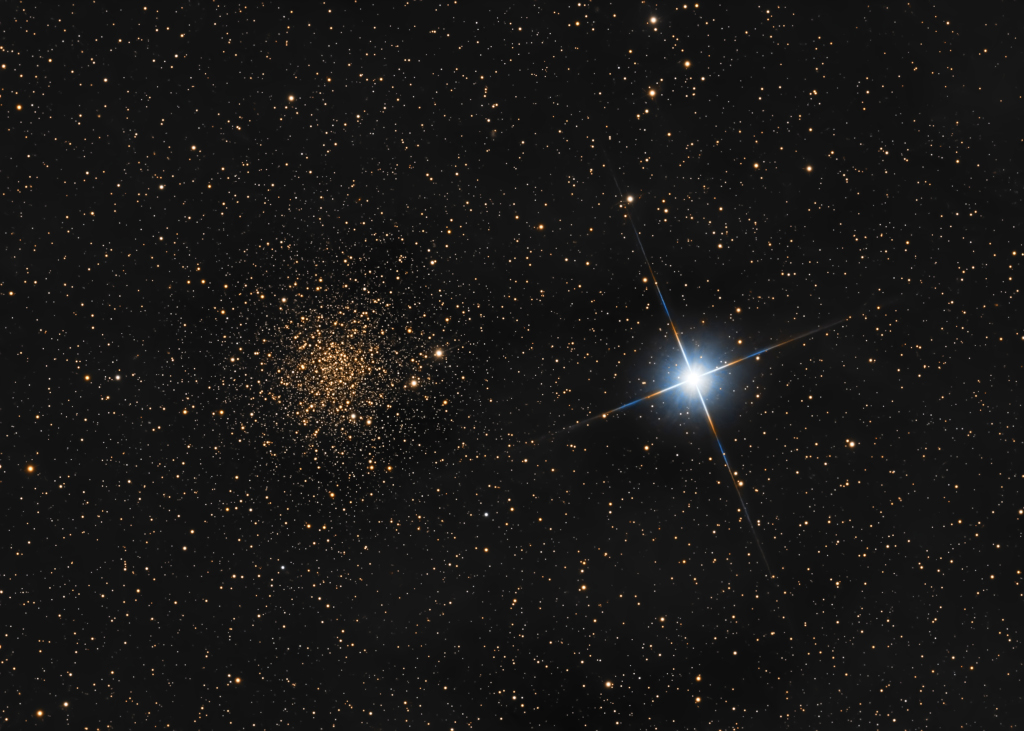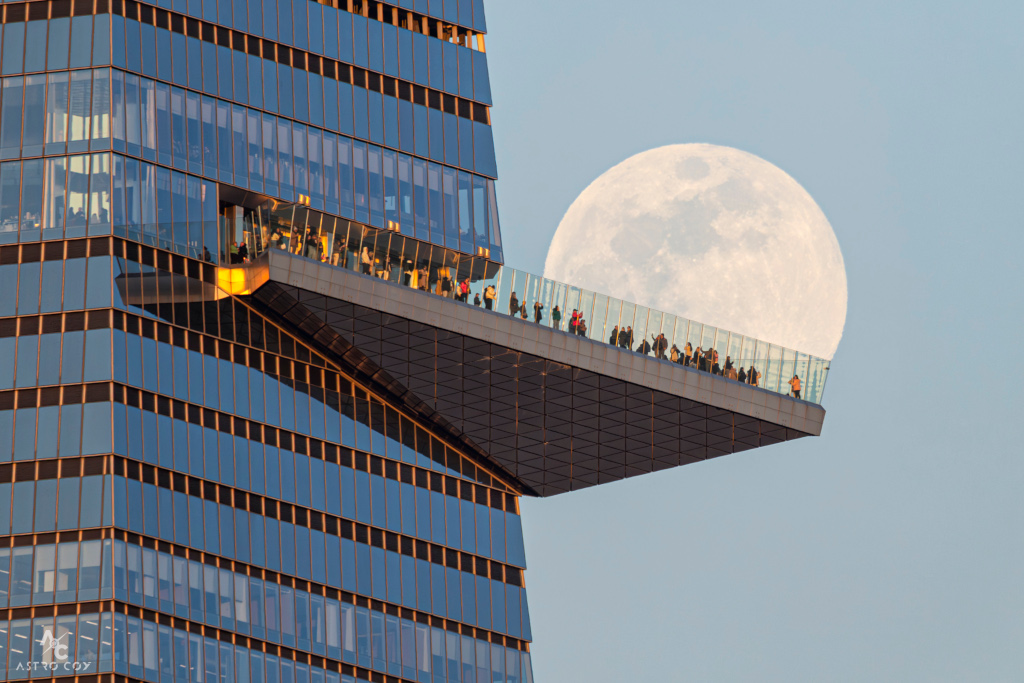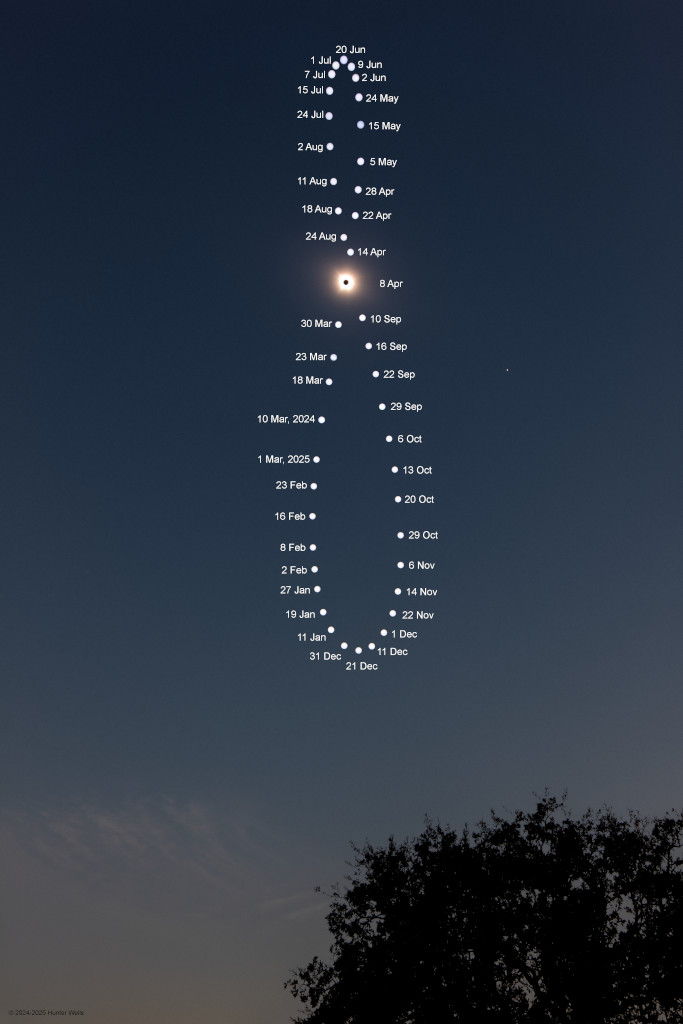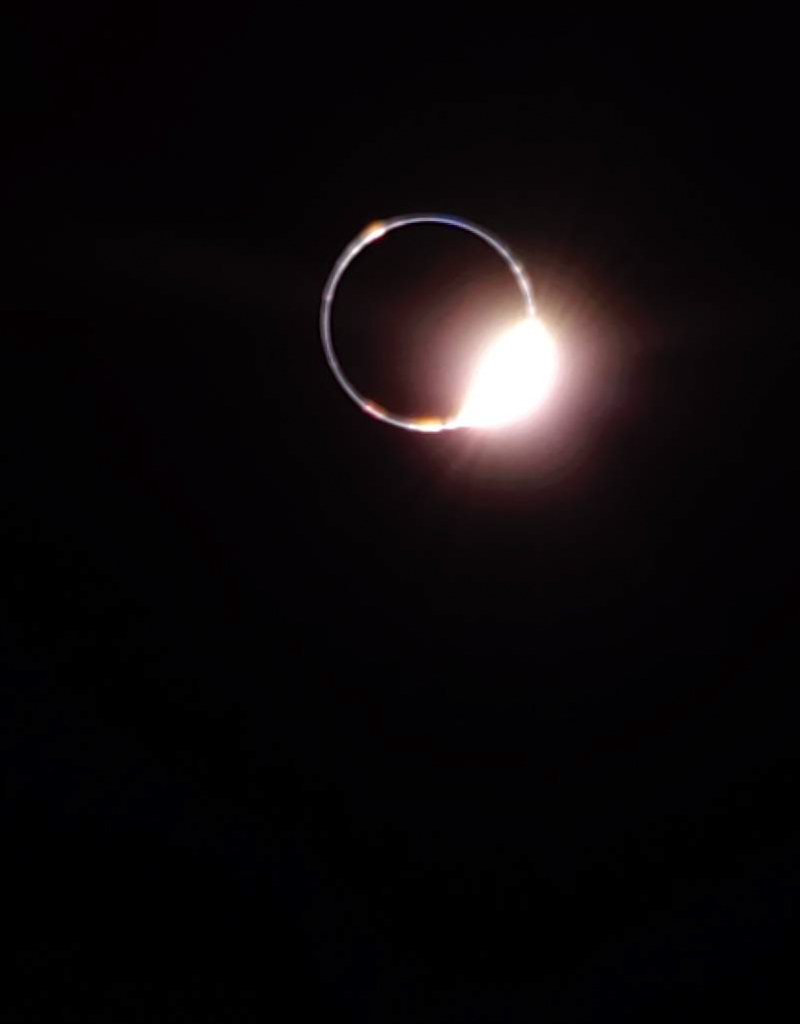Most globular star clusters roam the halo of our Milky Way galaxy, but globular cluster NGC 6366 lies close to the galactic plane. About 12,000 light-years away toward the constellation Ophiuchus, the cluster's starlight is dimmed and reddened by the Milky Way's interstellar dust when viewed from planet Earth. As a result, the stars of NGC 6366 look almost golden in this telescopic scene, especially when seen next to relatively bright, bluish, and nearby star 47 Ophiuchi. Compared to the hundred thousand stars or so gravitationally bound in distant NGC 6366, 47 Oph itself is a binary star system a mere 100 light-years away. Still, the co-orbiting stars of 47 Oph are too close together to be individually distinguished in the image.
Beautiful emission nebula NGC 6164 was created by a rare, hot, luminous O-type star, some 40 times as massive as the Sun. Seen at the center of the cosmic cloud, the star is a mere 3 to 4 million years old. In another three to four million years the massive star will end its life in a supernova explosion. Spanning around 4 light-years, the nebula itself has a bipolar symmetry. That makes it similar in appearance to more common and familiar planetary nebulae - the gaseous shrouds surrounding dying sun-like stars. Also like many planetary nebulae, NGC 6164 has been found to have an extensive, faint halo, revealed in this deep image of the region. Expanding into the surrounding interstellar medium, the material in the halo is likely from an earlier active phase of the O star. This gorgeous telescopic view is a composite of extensive narrow-band image data, highlighting glowing atomic hydrogen gas in red and oxygen in greenish hues, with broad-band data for the surrounding starfield. Also known as the Dragon's Egg nebula, NGC 6164 is 4,200 light-years away in the right-angled southern constellation of Norma.
Beautiful emission nebula NGC 6164 was created by a rare, hot, luminous O-type star, some 40 times as massive as the Sun. Seen at the center of the cosmic cloud, the star is a mere 3 to 4 million years old. In another three to four million years the massive star will end its life in a supernova explosion. Spanning around 4 light-years, the nebula itself has a bipolar symmetry. That makes it similar in appearance to more common and familiar planetary nebulae - the gaseous shrouds surrounding dying sun-like stars. Also like many planetary nebulae, NGC 6164 has been found to have an extensive, faint halo, revealed in this deep image of the region. Expanding into the surrounding interstellar medium, the material in the halo is likely from an earlier active phase of the O star. This gorgeous telescopic view is a composite of extensive narrow-band image data, highlighting glowing atomic hydrogen gas in red and oxygen in greenish hues, with broad-band data for the surrounding starfield. Also known as the Dragon's Egg nebula, NGC 6164 is 4,200 light-years away in the right-angled southern constellation of Norma.
In late March, the comet now designated C/2025 F2 SWAN was found independently by citizen scientists Vladimir Bezugly, Michael Mattiazzo, and Rob Matson while examining publicly available image data from the Solar Wind ANisotropies (SWAN) camera on the sun-staring SOHO spacecraft. Comet SWAN's coma, its greenish color a signature of diatomic carbon molecules fluorescing in sunlight, is at lower left in this telescopic image. SWAN's faint ion tail extends nearly two degrees toward the upper right across the field of view. The interplanetary scene was captured in clear but moonlit skies from June Lake, California on April 14. Seen against background of stars toward the constellation Andromeda, the comet was then some 10 light-minutes from our fair planet. Now a target for binoculars and small telescopes in northern hemisphere morning skies this comet SWAN is headed for a perihelion, its closest approach to the Sun, on May 1. That will bring this visitor from the distant Oort cloud almost as close to the Sun as the orbit of inner planet Mercury.
Made with a telescope shaded from bright sunlight by an umbrella, on April 5 a well-planned video captured a crescent Venus shining in clear daytime skies from Shoreline, Washington, USA at 11:57AM Pacific Time. It also caught the International Space Station in this single video frame. In close conjunction with the bright planet, the faint outline of the orbital outpost seen at a range of about 400 kilometers appears to be similar in size to the slender planetary crescent. Of course the ISS is much smaller than Venus. Now appearing as planet Earth's brilliant morning star and climbing above the eastern horizon in predawn skies, inner planet Venus was nearly 45 million kilometers from Shoreline.
From a garden on planet Earth, 38 hours of exposure with a camera and small telescope produced this cosmic photo of the M81 galaxy group. In fact, the group's dominant galaxy M81 is near the center of the frame sporting grand spiral arms and a bright yellow core. Also known as Bode's galaxy, M81 itself spans some 100,000 light-years. Near the top is cigar-shaped irregular galaxy M82. The pair have been locked in gravitational combat for a billion years. Gravity from each galaxy has profoundly affected the other during a series of cosmic close encounters. Their last go-round lasted about 100 million years and likely raised density waves rippling around M81, resulting in massive star forming regions arrayed along M81's spiral arms. M82 was left with violent star forming regions too, and colliding gas clouds so energetic that the galaxy glows in X-rays. In the next few billion years, their continuing gravitational encounters will result in a merger, and a single galaxy will remain. Another group member, NGC 3077 is below and left of the large spiral M81. Far far away, about 12 million light-years distant the M81 group galaxies are seen toward the northern constellation Ursa Major (the Great Bear). But in the closer foreground the wide-field image is filled with integrated flux nebulae whose faint, dusty interstellar clouds reflect starlight above the plane of our own Milky Way galaxy.
In dramatic silhouette against a cloudy daytime sky over Paris, France, gargoyles cast their monstrous gaze outward from the west facade of Notre Dame Cathedral. Taken on March 29, this telephoto snapshot also captures the dramatic silhouette of a New Moon against the bright solar disk in a partial solar eclipse. Happening high in Parisian skies, the partial eclipse was close to its maximum phase of about 23 percent. Occurring near the end of the first eclipse season of 2025, this partial solar eclipse followed the total eclipse of the Full Moon on March 13/14. The upcoming second eclipse season of 2025 will see a total lunar eclipse on September 7/8 and partial solar eclipse on September 21. The partial solar eclipse will be seen only from locations in planet Earth's southern hemisphere.
Scanning the skies for galaxies, Canadian astronomer Paul Hickson and colleagues identified some 100 compact groups of galaxies, now appropriately called Hickson Compact Groups. The four prominent galaxies seen in this intriguing telescopic skyscape are one such group, Hickson 44. The galaxy group is about 100 million light-years distant, far beyond the spiky foreground Milky Way stars, toward the constellation Leo. The two spiral galaxies in the center of the image are edge-on NGC 3190 with its distinctive, warped dust lanes, and S-shaped NGC 3187. Along with the bright elliptical, NGC 3193 (above and left) they are also known as Arp 316. The spiral toward the lower right corner is NGC 3185, the 4th member of the Hickson group. Like other galaxies in Hickson groups, these show signs of distortion and enhanced star formation, evidence of a gravitational tug of war that will eventually result in galaxy mergers on a cosmic timescale. The merger process is now understood to be a normal part of the evolution of galaxies, including our own Milky Way. For scale, NGC 3190 is about 75,000 light-years across at the estimated distance of Hickson 44.
Recorded from 2024 March 10, to 2025 March 1, this composited series of images reveals a pattern in the seasonal drift of the Sun's daily motion through planet Earth's sky. Known to some as an analemma, the figure-eight curve was captured in exposures taken on the indicated dates only at 18:38 UTC from the exact same location south of Stephenville, Texas. The Sun's position on the 2024 solstice dates of June 20 and December 21 would be at the top and bottom of the curve and correspond to the astronomical beginning of summer and winter in the north. Points that lie along the curve half-way between the solstices would mark the equinoxes. The 2024 equinox on September 22, and in 2025 the equinox on March 20 (today) are the start of northern fall and spring. And since one of the exposures was made on 2024 April 8 from the Stephenville location at 18:38:40 UTC, this analemma project also reveals the solar corona in planet Earth's sky during a total solar eclipse.




















